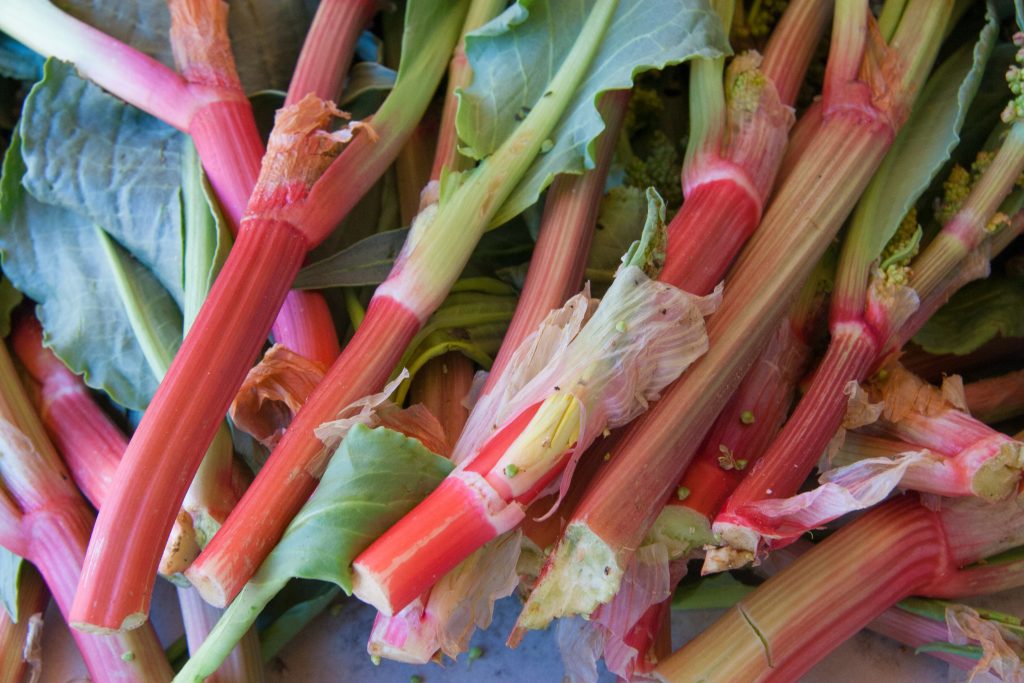
My husband builds model rockets. It’s a perfect hobby for him, one that combines art and science and also lets him get outdoors. I’ve been wanting to go to one of the monthly launches, so last weekend we got in the car at the ungodly hour of 6 am (ungodly because it was Saturday) and headed out to the launch site. Only to find that the launch date had been changed. Michael was very apologetic, but no apology was necessary. Because the landscape surrounding the site was full of Rumex hymenosepalus (aka wild rhubarb), a very succulent species of dock I’d been wanting to try.
I’d seen it last year at Chaco Canyon, but the NPS frowns on foraging at National Historical Sites, so I refrained. This time, however, Michael and I harvested a bunch of flower stems and brought them home.
I’d read that the bright red flower stems of this dock made an excellent rhubarb substitute, and the color was certainly similar. A little research showed that some people use the red midribs of the foliage, while others prefer the flower stems. Both are safe to eat, but since the leaf midribs of the plants I found were barely red, I thought the flower stems would give me better color.
This is the most ornamental dock I’ve seen. The leaves are slightly succulent and a lovely blue-gray color and it’s especially pretty in full bloom, with it’s pinkish flowers and red flower stalks. I’d be tempted to plant it in my garden if I didn’t know it doesn’t like altitudes quite this high. (I live at 7,000 feet.) It requires full sun and sandy soil, and its large, tuberous roots make it very drought tolerant. Historically, the roots have been used as both a dye source and for leather tanning.
But let’s talk about how to eat this plant. Thanks to the folks at Southwest Foraging, I knew that the juice of the flower stems makes a refreshing tea. As I washed and chopped the stems, they reminded me so much of Japanese knotweed (also a member of the Polygonaceae family) that I wondered if it would have the same vegetal edge to its flavor, and if the juice would be pink while the stems themselves would turn green from cooking. Yes on all counts. In fact, I feel a little less sad about missing the vast Japanese knotweed harvests of the NE, now that I know how similar the flavor, color, and texture of wild rhubarb is.
To juice your wild rhubarb, wash the stems and chop them into small pieces, approximately 1/2 inch thick. Transfer these to a sauté pan and add just enough water to cover the stems. Cook over medium heat until the water begins to simmer, then reduce the heat to low. Continue to cook until the stems are soft enough to mash with a potato masher, then transfer the mixture to a jelly bag and let the juice drip into a bowl.
I toyed with the idea of making a syrup from the juice, then basing a cocktail on that syrup, and chances are I’ll try that in the future. But for some reason, I couldn’t stop thinking about jello, so that’s what I made. It’s simple, it’s pretty, and its flavor is both sweet and tart. A little whipped cream on top makes for a striking and balanced dessert. I hope you like it!
This recipe is scalable, so you can work with whatever amount of juice you have. 1 Tbs. of powdered gelatin will solidify up to 2 cups of liquid.
What You’ll Need to Make Wild Rhubarb Jello
- 1 1/2 cups wild rhubarb juice (divided into 1 cup and 1/2 cup batches)
- 1/2 cup sugar
- 1 Tbs. powdered gelatin
What You’ll Do to Make Wild Rhubarb Jello
Combine 1 cup of wild rhubarb juice with the sugar in a saucepan, and whisk to dissolve the sugar over medium heat. When the syrup begins to bubble around the edges, remove it from the heat and set it aside.
While the juice is heating, pour the remaining 1/2 cup of wild rhubarb juice into a bowl, and sprinkle the gelatin on top to dissolve. Let it sit for 1 – 2 minutes, then whisk it into the heated syrup. Continue to whisk to completely dissolve the gelatin, then pour the mixture into dishes and refrigerate.
For an extra fancy touch, serve with fresh whipped cream.

Leave a Reply